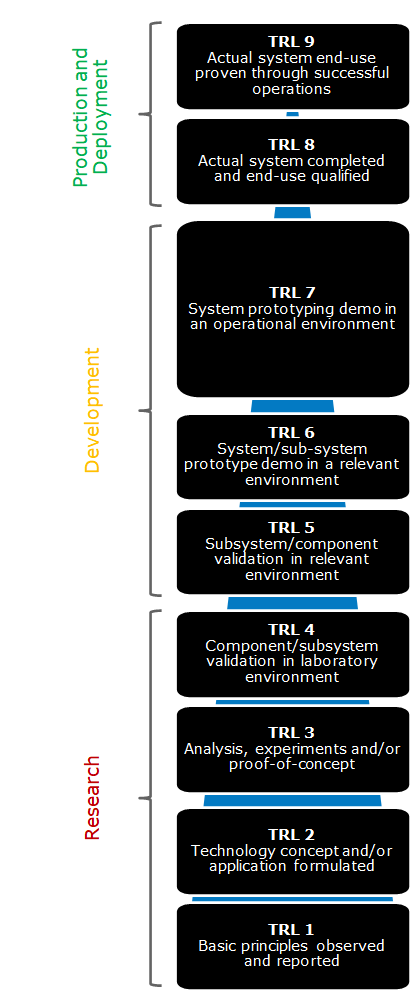Technology Readiness Levels (TRLs)
What are Technology Readiness Levels?
Technology Readiness Levels (TRLs) are shorthand labels for pre-defined qualitative characterization of how mature a technology is, for real-world use. They are not quantitative, 100%-objective measures of readiness, but instead represent a subjective, but expert, view of the current or future maturity of a given technology.
INEMI’s approach to TRLs
The definitions used here are essentially those provided by NASA with only minor changes in terminology. The core text is taken from Appendix E of reference 1 and from reference 2. The changes are simply to reflect what hardware and systems are in electronics rather than space applications.
TRL Definitions

List of Technology Readiness Levels (TRLs)
TRL 1: Basic principles observed and reported
Characterized by the transition from scientific research to applied research, with scientific knowledge generated underpinning technology concepts/applications. Outputs should include peer reviewed documentation of research underlying the proposed concept/application.
TRL 2: Technology concept and/or application formulated
Applied research. Invention begins, practical application is identified but is speculative, no experimental proof or detailed analysis is available to support the conjecture. Results include documented descriptions of the application/concept that addresses feasibility and benefit.
TRL 3: Analytical and experimental critical function and/or characteristic proof-of- concept
Proof of concept validation. Research and development are initiated, including analytical and laboratory studies to validate predictions regarding the technology. Analytical/experimental results validating predictions of key parameters are documented.
TRL 4: Component/subsystem validation in laboratory environment
A low fidelity system/component prototype is built and operated to demonstrate basic functionality in a laboratory environment. Test performance demonstrating agreement with analytical predictions is documented. Also documented is the definition of a potentially relevant environment.
TRL 5: Subsystem/component validation in relevant environment
A medium-fidelity component and/or subsystem, with realistic support elements, is built and operated for validation in a relevant environment so as to demonstrate overall performance in critical areas. Test performance demonstrating agreement with analytical predictions is documented. Definition of scaling requirements and performance predictions are documented for subsequent development phases.
TRL 6: System/sub-system model or prototype demonstration in a relevant environment
A high-fidelity prototype of the system/subsystems that adequately addresses all critical scaling issues is built and tested in a relevant environment to demonstrate performance under critical environmental conditions. Limited documentation available. Engineering feasibility fully demonstrated in actual system application.
TRL 7: System prototyping demonstration in an operational environment
A high-fidelity prototype or engineering unit that adequately addresses all critical scaling issues is built and functions in the actual operational environment and platform. Well integrated with collateral and ancillary systems. Limited documentation available.
TRL 8: Actual system completed and end-use qualified through test and demonstration in an operational environment
The final product in its final configuration is successfully demonstrated through test and analysis for its intended operational environment and platform. If necessary, life testing has been completed. Fully integrated with operational hardware and software systems. Most user documentation, training documentation, and maintenance documentation completed. All functionality tested in simulated and operational scenarios. Verification and validation completed.
TRL 9: Actual system end-use proven through successful operations
Fully integrated with operational hardware/software systems. Actual system has been thoroughly demonstrated and tested in its operational environment. All documentation completed. Successful operational experience. Sustaining engineering support in place.
References
National Aeronautics and Space Administration (NASA), “NASA Systems Engineering Processes and Requirements (w/Change 2),” Report NPR 7123.1C, 2020.
National Aeronautics and Space Administration (NASA), “Definition Of Technology Readiness Levels,” https://esto.nasa.gov/files/TRL_definitions.pdf.
